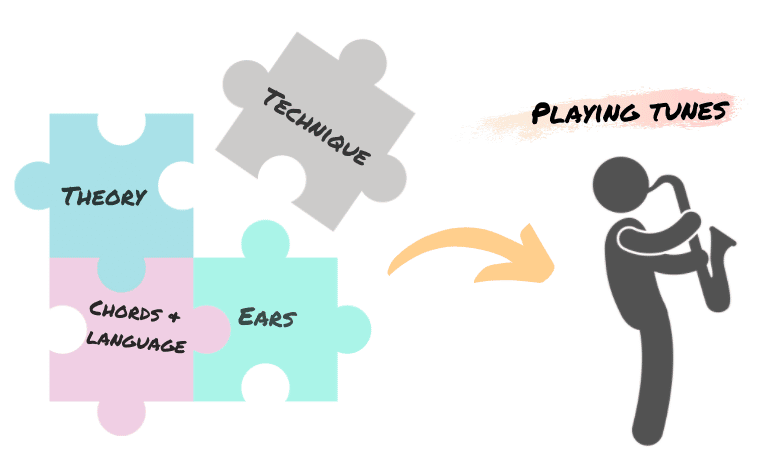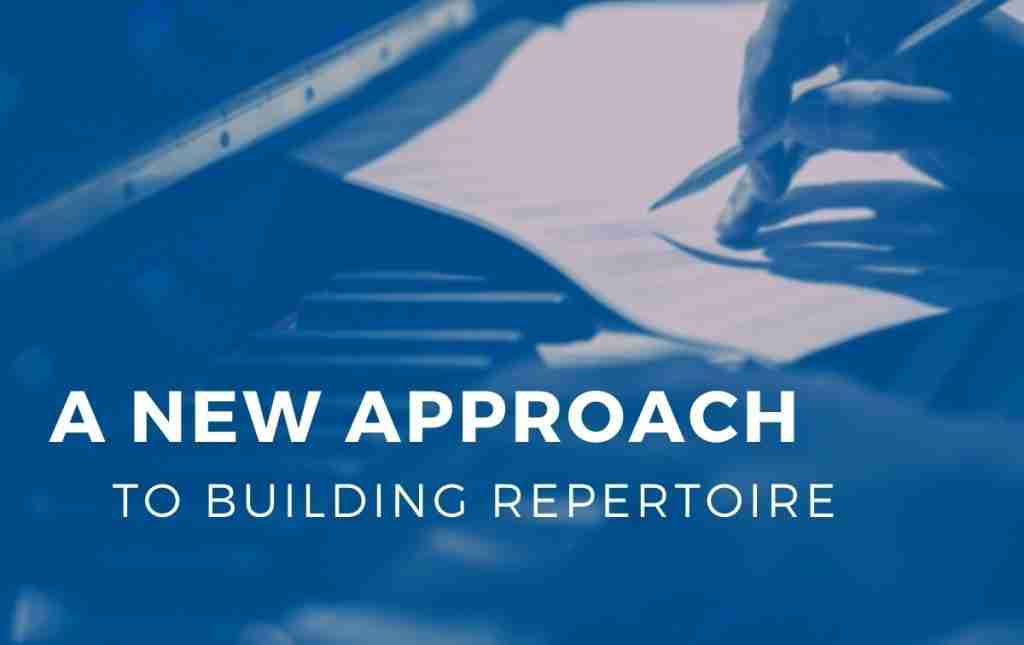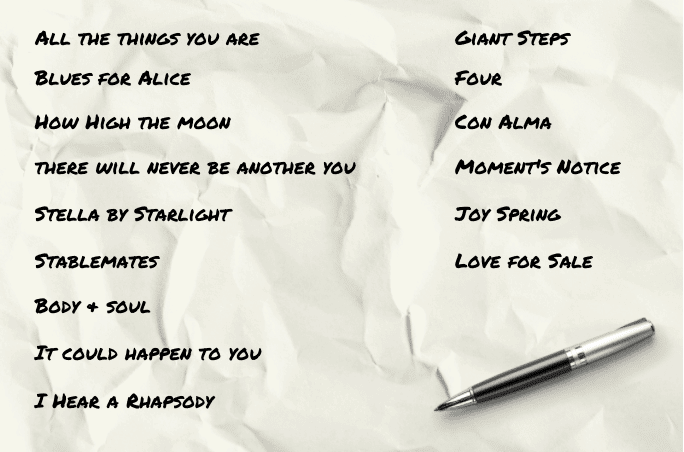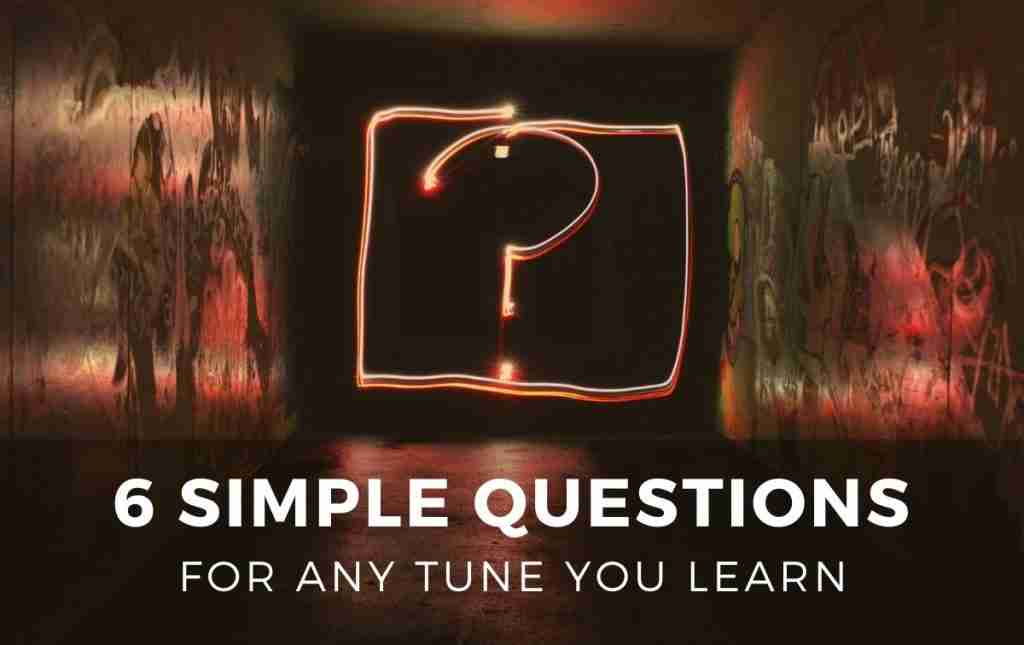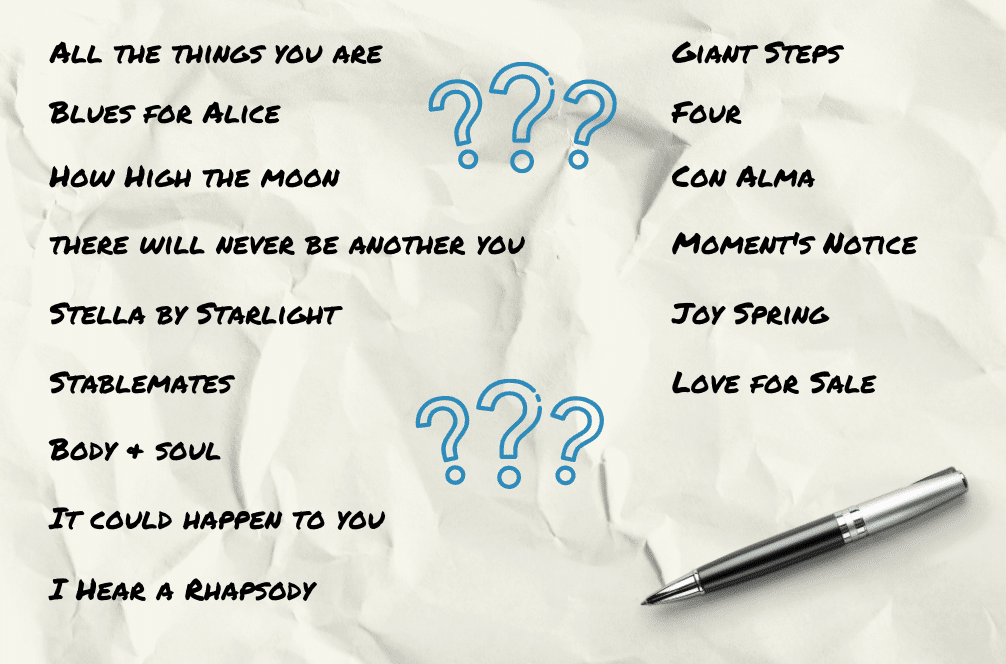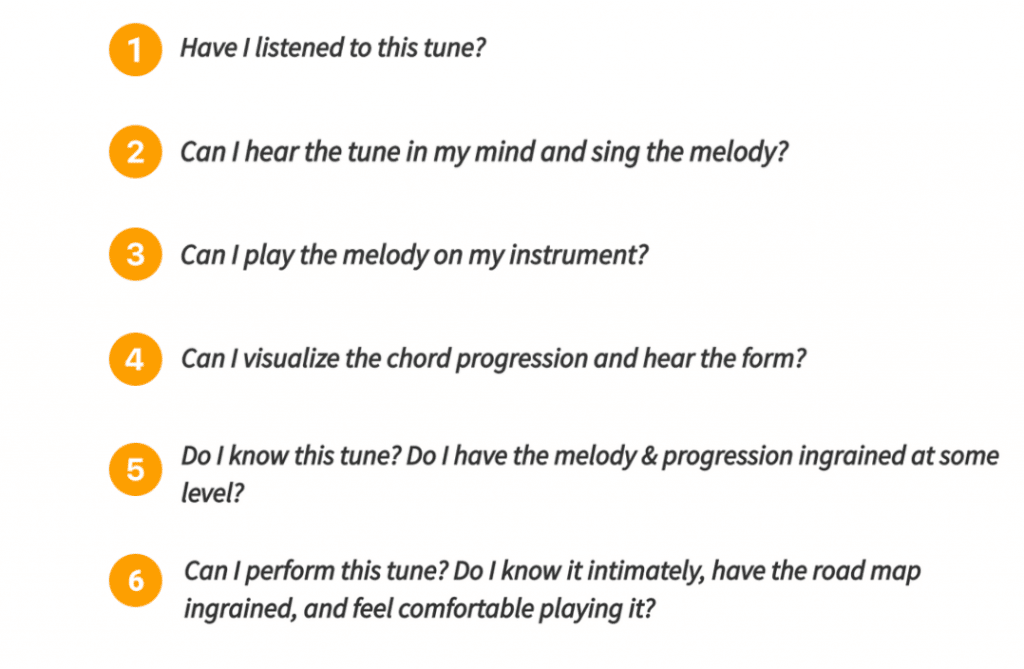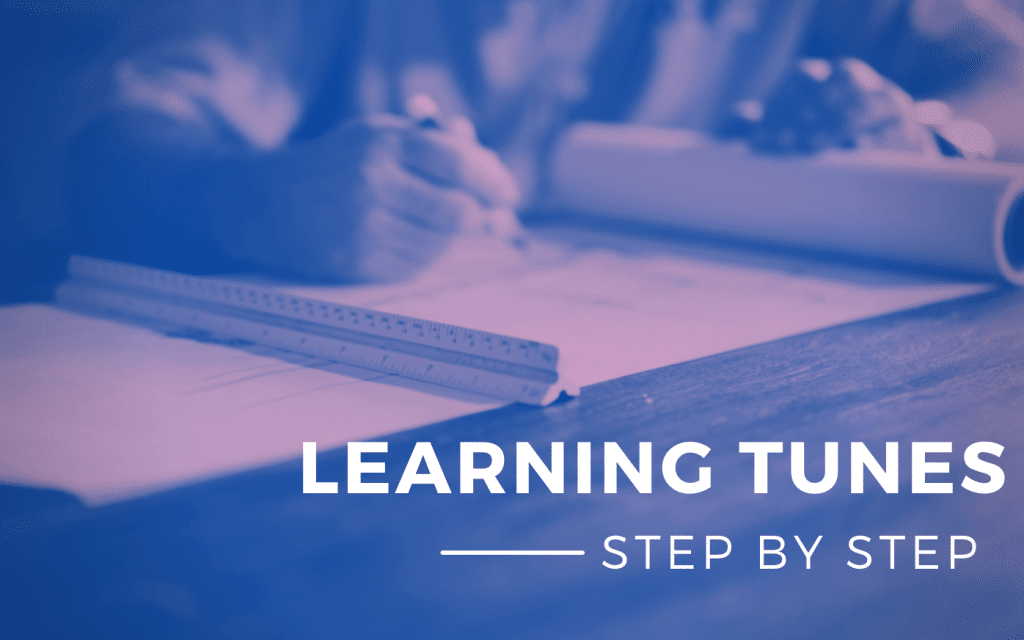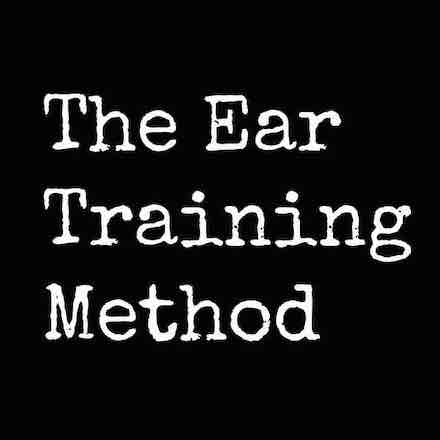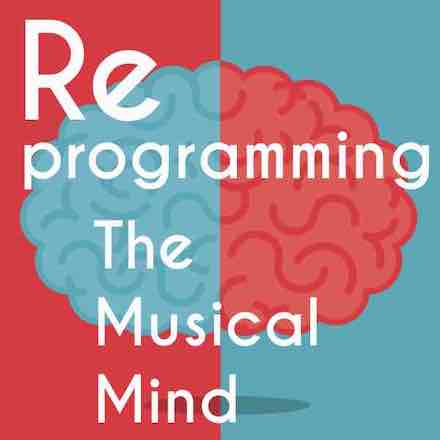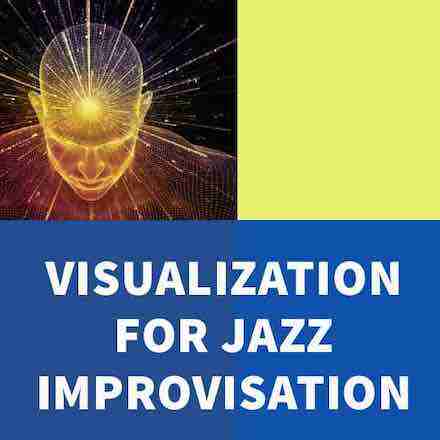Let’s face it, as musicians we’re all striving to know more tunes that we can improvise over with ease…because at the end of the day, this is how you get your musical message across to the listener.
Whether it’s playing with our fellow musicians, walking into jam sessions, performing concerts or gigs, taking lessons, or even someone seeing you and saying “Oh, you’re a musician? Play something for me…”
In all of these situations you need to have something that you can play! A few tunes that showcase your musical skills or a song that you can easily navigate and create a musical moment with other musicians.
This is why learning tunes and building a repertoire of jazz standards that you sound great on is constantly on the minds of any serious musician…
The only problem is that the process of building a lasting repertoire of tunes is not exactly easy…in fact, it can be a thorn in the side of many of players.
What often starts as an enjoyable musical endeavor can quickly transform into something that feels like a burden. There’s the pressure to immediately know dozens of tunes, the frustration of never knowing enough, even anxiety of getting put on the spot…
This is something every player can relate to, and the frustrating thing is that no matter how much you practice, it seems like you can never learn enough tunes or find an easy way to remember all of that information.
So what can you do to improve??
In this lesson we’ll show you how to take a different approach to the process of learning tunes, and why successfully building a solid repertoire is something that involves all of your musical skills…
Why tunes are important
Before we get started, let’s ask the obvious question: What’s so important about learning tunes?
I mean, what’s all the fuss about? Aren’t tunes just one of the many elements you need as a proficient musician, another piece of your practice routine like scales, chords, and technique that you need to check off your list?
While this may seem like the case at first, the truth is learning tunes is more than just another practice exercise…it’s the point of why you’re playing!
You see, everything that you practice goes into the goal of performing a tune or playing music. Tunes – whether jazz standards, pop songs, or original compositions – are your vehicle for improvising, expressing yourself, and communicating to a listener.
All of that technique, sound, range, and theory that you practice is simply a piece of the puzzle that goes into your ability to make music…
Think about it this way – if someone off the street asked you to play something, they wouldn’t want to hear a scale pattern or a ii-V lick, and they wouldn’t be moved by fancy chord substitutions…
They would want to hear melody, a tune that they can easily follow with their ears. And this is what we often forget in the bubble of our practice rooms and musician circles.
The things that we value in our practice aren’t necessarily what the average listener will hear or even care about. And this is precisely why it’s beneficial to step back and reconnect with the reason we’re practicing in the first place.
Regardless of the style of music you play, you need to have a working repertoire of tunes that demonstrate your musical skills, that are vehicles for your musicianship and musical expression.
This is why learning tunes is essential for every musician and why finding an effective way to build a repertoire in the practice room is important…
A new perspective on tunes
If you want to change your results and success with learning tunes, it goes back to your definition of what the process looks like…
For many, the typical approach to repertoire starts with a long list of jazz standards – you just have to memorize them one by one. Maybe you open up a fake book and memorize a tune note by note & chord by chord, covering one or two songs in a practice session…simple enough, right?
The expectation is that over time you’ll build up this vast library of tunes that you’ve memorized, melodies and chord progressions that you can recall in an instant…like a computer pulling up a file from a massive database and spitting out the information.
From this perspective, building a repertoire comes down to checking tunes off a list as quickly as you can…
However, the trouble comes when you actually get to work on the nuts and bolts of learning these tunes in the practice room. This is where it hits you – you’re looking at a long list of tunes that you don’t know.
You get that feeling of being immediately overwhelmed – how are you going to memorize all of this information? What’s more, once you think of 5 tunes you want to learn, there are 20, 30 or even 50 more that you don’t know!
And this is where the anxiety and rush to learn tunes kicks in. But you don’t have to get stuck in this never-ending routine, a simple change in your perspective can get you moving in the right direction.
The trick to stopping this endless cycle is changing your perspective of learning tunes and building repertoire, transforming it from a tedious memorization exercise into an ongoing process that involves every aspect of your musicianship.
Rather than approaching a tune list as homework, look at any set of tunes that you’re learning as a “living list.” A list that is continually being updated and growing. It’s a work in progress that is directly tied to your musical skills.
Remember, you don’t have to learn everything at once…you don’t even have to learn an entire tune at once!
The reality is that you’re going to be working on these tunes for the rest of your musical life, always improving them bit by bit. And this removes some of the pressure – the goal isn’t perfection, it’s simply to take small steps forward each practice session.
The Six Questions to ask
Now it’s time to take a different approach to those lists of tunes…
Take a moment and make a short list of tunes that you want to learn. Maybe some ballads that you’ve been meaning to study, a few common standards, some Monk tunes, etc.
Aim for a list of 10 to 15 tunes that you’re serious about learning. For this example, we’ll stick with the list from above…
As you look at a list like this, the goal at the end of all your work is to be able to confidently perform each tune. But remember, this can’t be done in a few practice sessions, it takes time!
So rather than getting overwhelmed with everything that you don’t know, let’s instead begin with what you do know.
This means getting specific and identifying the small steps you need to improve each tune, steps that can easily be achieved in a practice session.
For each tune on your list that you want to learn, ask these 6 simple questions:
This process will show you the different levels that you’re currently on with each tune on your list.
Effectively learning a tune that you can perform isn’t as simple as “I know it” or “I don’t know it.” There are small steps in between that you need to go through to master each tune, and this process gets the wheels moving.
Categorizing the tunes on your list:
With these six questions you can start categorizing each tune in terms of how familiar you are with it and what you need to do to get it up to speed in the practice room.
For each tune, you can group it into one of the following categories:
- Don’t know it
- Have listened to it
- I can sing the melody
- I understand and can visualize the function and form of the chord progression
- Have the melody and chords memorized, mentally and aurally
- Have this tune ingrained and have concepts for improvisation
As you move through your list, realize that not every tune will be at the same level – that’s perfectly fine. There is no finish line or deadline that you need to finish each tune by, each standard is always improving.
Your goal now is to raise the level of every tune on the list over time, step by step...
Breaking down the process
The purpose of this process is to give you small achievable steps that you can focus on in and out of the practice room.
In essence transforming the process from a massive memorization project into small musical projects that are actually fun and achievable.
As you select a tune, take your time and go slowly, completely ingraining each step along the way. Each tune on your list will be in a different place, so you might be starting out listening to some tunes while polishing up others.
Here’s how you should approach the six different steps to learning the tunes on your list from a practice perspective…
Step 1 – Listen to the tune!
At the most basic level, your goal is to at least listen to every tune on your list. Before you worry about notes, keys, and chords, find a recording and absorb the music!
This is an easy first step for any tune you don’t know, and it doesn’t have to be done in a practice room or near your instrument.
For instance, maybe on that list above you’ve listened to most of the tunes, but not I Hear a Rhapsody…
The important part here is to make sure you are doing some focused and repeated listening. The main objective is to absorb and ingrain the tune.
As you implement the process in your routine, this listening step might be all that you do on a particular tune for the day. It’s one step forward and better than not knowing the tune at all!
Step 2 – Sing the melody
The next step after you’ve thoroughly listened to a new tune is to sing the melody.
This might be one of the most important steps in the learning process and it is essential in ingraining the tune on a musical level.
- First sing the melody along with the recording:
- Then sing the melody without the recording – This is where you’ll know if you actually have it ingrained. Confidently sing each interval and phrase with intent and feeling by yourself, without the aid of the recording.
Go phrase by phrase, hear each interval and the relationship to the underlying chords and be sure to learn the lyrics if there are any.
Step 3 – Play the melody on your instrument
This is where the connection between your ears and your instrument comes in handy!
If you can sing it, you should be able to play it. The benefit here is that you’re learning the melody from an ingrained internal source rather than from notes on a page or music theory.
Step 4 – Learn & visualize the chord progression and hear the form
This step might be the slowest or most tedious, but will have the most benefit in raising the level of your ears and understanding of harmony.
Go slowly chord by chord, listening for chord quality, root movement, common progressions, and harmonic relationships.
Also make sure you learn the form of the tune. The goal isn’t to simply memorize the chords, but to understand the function of each chord in the larger progression.
Step 5 – Review the Melody and Chord progression
Play through the tune, reviewing the melodic lines and the harmonic relationships. Then work on improvising through the chord progression.
At this point you can begin to study how great players navigate the chord progression and form:
Step 6 – You “Know” this tune and continue to improve it
The goal at this stage is to have the tune completely ingrained and ready to perform. This includes:
- Having language and improvisation techniques
- Being able to hear and visualize the entire form of the tune rather than thinking through individual chords
- Hearing longer phrases to improvise over the progression
- The ability to substitute chords in the progression
Keep in mind that you are never really done with this step, there’s always more to do on any tune!
The process that utilizes every musical skill
As you can see, the process of learning tunes isn’t just memorizing notes and chords like many players think…
When you breakdown the individual steps of learning a tune you quickly realize it’s more than a memorization exercise, it’s more about you and your musical skills.
One big problem is that the process of learning tunes is often separated from other musical skills and treated as its own exercise. As a result, we often ignore the crucial role our musical skills play in the learning process.
The benefit of learning tunes isn’t just expanding your repertoire or “knowing more tunes,” it’s also building and informing your approach to melody and harmony.
The more melodies you know, the more successful you’ll be at creating your own. And the more harmonic structures you’ve studied, the easier they’ll be to navigate and recognize in your own solos.
The higher the level of your musical skills and the more tunes you’ve studied, the easier the entire process will become!
…and this is why the best musicians are simply better at learning tunes!
For instance, take a player that’s just starting out with learning tunes. For them the approach to learning a tune is a mental process consisting entirely of memorization.
They go note by note and chord by chord, the task of learning a few tunes becomes a massive undertaking! And the only way they can perform a tune is with it entirely memorized, the last step we outlined above.
Now compare this to a much more experienced musician that has developed their ears, studied harmony, and has a few sets of tunes in their repertoire.
For them the entire process is strikingly easier – learning melodies by ear and figuring out chord progressions from the recording. At this stage they can perform tunes that they can sing and might even be able to get by on tunes they’ve only heard.
The difference isn’t the tunes themselves or the process, it’s the skills that each player brings to the table.
Remember, learning tunes isn’t an isolated practice exercise, it’s something that requires and benefits from all of your musical skills. As you work on building your repertoire with this six part approach, don’t forget to include every piece of your musicianship!


